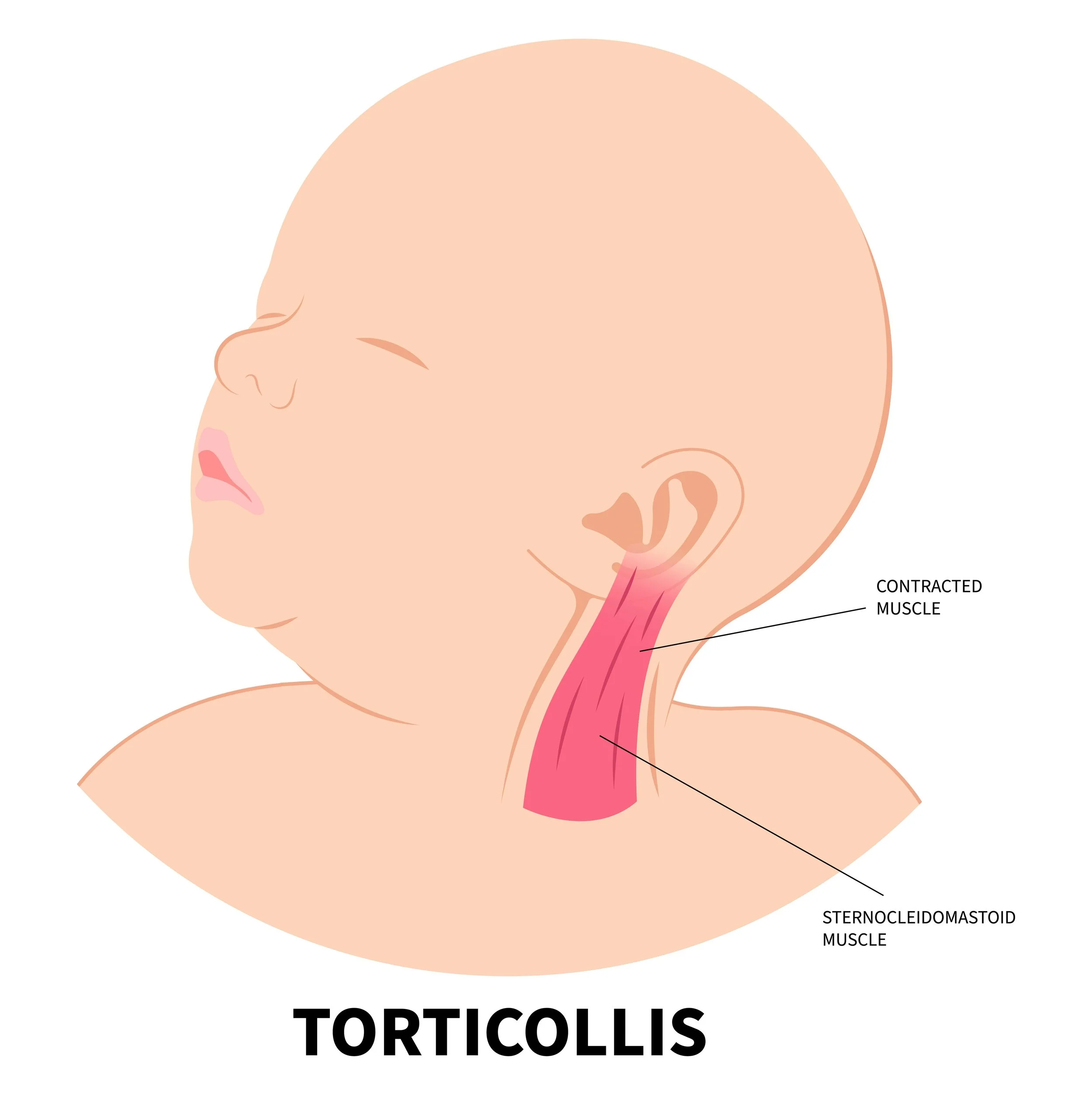What Every Parent Needs to Know About: Torticollis
What is Torticollis?
Torticollis is a condition where baby develops tightness in the muscles of their neck, typically the sternocleidomastoid muscle (more easily called the SCM!) The most common presentation is a baby who tilts their head towards one shoulder and rotates their head to the opposite side, but it can present in many different ways. Torticollis is associated with difficulty moving the neck, plagiocephaly/brachycepahly (AKA flat head syndrome,) gross motor delays, abnormal movement patterns, abnormal vestibular and visual development, and more.
Torticollis can be present at birth or develop over the first couple months of life. When we think about baby in the womb, most babies have their head in one position for the last several weeks. When they are born, their brain still associates the womb with comfort (think about the many ways we try to replicate the womb to soothe babies like shushing/white noise, rocking, swaddling, etc) and many babies position their head the same way it was in the womb for comfort! There can also be environmental or medical reasons why a baby prefers to position their head in a certain way. Any repeated positioning can lead to torticollis.
Torticollis can feel confusing because the most common presentation is to tilt their head one way and rotate it the opposite way! Don’t worry, we will be able to tell you exactly where your baby is tight.
Is Torticollis common in babies?
Torticollis is the most common developmental condition that I see in my clinic. And one reason that we have seen more babies develop this condition is because society changes over time.
The biggest change in recent decades is the introduction of back to sleep. Safe sleep recommendations include placing baby on their back for sleep, and many babies will position their head to a preferred side.
As parents we have more options for places to put our babies like swings, bouncer chairs, loungers, etc. While these are great tools to have, and I used them with my own daughter, it can contribute to repeated positioning.
Many families are on the go with more time in the carseat and stroller. This can also lead to repeated positioning and decrease the amount of floor play baby is able to do to help them stretch out and develop strength.
Risk factors for Torticollis include:
Multiple gestation pregnancy
Baby who is large for gestational age
Low amniotic fluid in pregnancy
Difficult delivery with or without birth injury
Baby spends time in NICU after birth
“Good” sleepers or babies who are content in one place for longer periods of time
Babies who struggle to participate in tummy time (learn more about tummy time here)
Signs of Torticollis:
Baby prefers to tilt or turn their head to one side a majority of the time, even if they can turn their head to both sides (pro tip: look back at pictures of your baby and check if their head is always in the same position)
Baby’s neck is stiff and they have difficulty turning their head to one side
Baby has a hard time breast or bottle feeding on one side
Baby prefers to move one arm/leg over the other or brings one hand to their mouth more often
Baby has a flat spot on one side of their head (learn more about flat head syndrome here!)
Baby has increased redness or traps more debris on one side of their neck
Baby has a lump on their neck muscle
When to seek support from a pediatric physical therapist:
If you notice any of the signs of torticollis listed above we recommend being evaluated by a pediatric physical therapist
Research supports that starting physical therapy earlier leads to shorter overall treatment times. We recommend seeking support as soon a baby shows signs of torticollis, from birth! Taking a “wait and see” approach can lead to baby needing a longer treatment program.
What does treatment for Torticollis look like?
At the evaluation we will:
Talk to you about your concerns, what you have tried at home, and let your baby warm up to us
Complete a full assessment of your baby including range of motion and strength throughout their body, motor skills, movement patterns, cranial shape, and more
Make a treatment plan to support your unique baby and teach you exercises to start at home right away to help them
Treatment for torticollis should address the whole body, and neck stretches alone are not enough to treat torticollis. Sessions can include:
Stretching of the neck muscles but also addressing shoulder, trunk, and hip mobility
Strengthening of the neck muscles on the opposite side
Infant massage
Retraining baby’s brain to hold their head in midline
Monitoring head shape and educating you on repositioning strategies
Floor play activities to support gross motor development
Handling interventions to support symmetrical movement patterns
If you think your baby might have a side preference or torticollis, or you want support to prevent these conditions contact us today! We offer a range of developmental services and skilled physical therapy intervention to help your baby bloom!
References:
Kaplan SL, Coulter C, Sargent B. Physical Therapy Management of Congenital Muscular Torticollis: A 2018 Evidence-Based Clinical Practice Guideline From the APTA Academy of Pediatric Physical Therapy. Pediatr Phys Ther. 2018 Oct;30(4):240-290. doi: 10.1097/PEP.0000000000000544. PMID: 30277962; PMCID: PMC8568067.
The information provided in this blog post is for educational purposes only and not intended to be medical advice. Consult a medical professional or healthcare provide for diagnosis and treatment.

